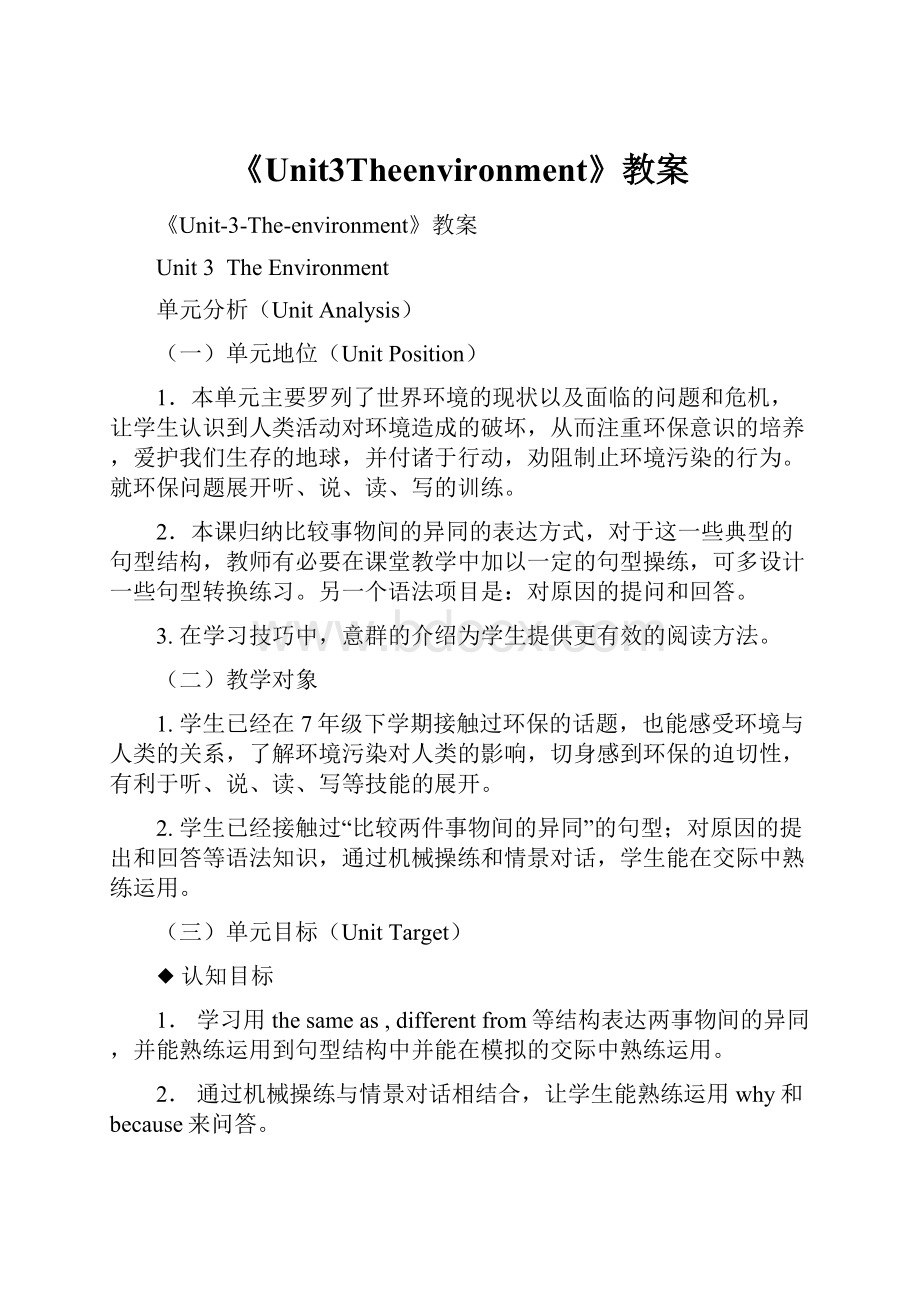《Unit3Theenvironment》教案.docx
《《Unit3Theenvironment》教案.docx》由会员分享,可在线阅读,更多相关《《Unit3Theenvironment》教案.docx(16页珍藏版)》请在冰豆网上搜索。

《Unit3Theenvironment》教案
《Unit-3-The-environment》教案
Unit3TheEnvironment
单元分析(UnitAnalysis)
(一)单元地位(UnitPosition)
1.本单元主要罗列了世界环境的现状以及面临的问题和危机,让学生认识到人类活动对环境造成的破坏,从而注重环保意识的培养,爱护我们生存的地球,并付诸于行动,劝阻制止环境污染的行为。
就环保问题展开听、说、读、写的训练。
2.本课归纳比较事物间的异同的表达方式,对于这一些典型的句型结构,教师有必要在课堂教学中加以一定的句型操练,可多设计一些句型转换练习。
另一个语法项目是:
对原因的提问和回答。
3.在学习技巧中,意群的介绍为学生提供更有效的阅读方法。
(二)教学对象
1.学生已经在7年级下学期接触过环保的话题,也能感受环境与人类的关系,了解环境污染对人类的影响,切身感到环保的迫切性,有利于听、说、读、写等技能的展开。
2.学生已经接触过“比较两件事物间的异同”的句型;对原因的提出和回答等语法知识,通过机械操练和情景对话,学生能在交际中熟练运用。
(三)单元目标(UnitTarget)
◆认知目标
1.学习用thesameas,differentfrom等结构表达两事物间的异同,并能熟练运用到句型结构中并能在模拟的交际中熟练运用。
2.通过机械操练与情景对话相结合,让学生能熟练运用why和because来问答。
3.能描述人类活动对环境产生的影响及此过程中环境发生的变化。
4.能就环保话题发表自己的见解。
5.了解识别意群,改善阅读习惯。
◆情感目标
通过谈论环境问题,让学生真实地了解到当今人类活动对环境造成的破坏,环境的恶化
对人类生活的影响,认识到环保的重要性及迫切性,从而唤起学生更加爱护人类和动植物赖以生存的大自然的情感态度。
从小事做起,从我做起,一齐参与环保的行动。
◆能力发展目标
1.在听、说、读、写等语言综合实践运动中运用所学重点词汇、句型和语法。
2.在学习中提高交流和传递信息的能力,在交际中能表达个人的观点和列举于、原因,初步培养学生提出问题、分析问题和结局问题的能力。
3.指导学生在模拟交际中运用所学知识,培养学生探究学习、合作学习和自主学习的能力
(四)单元重点(UnitPoints)
1.词汇:
●关键词:
concern,atmosphere,temperature,guess,green,lifeless,fuel,coal,result,increase,sealevel,destory,nature,surface,soil.Flood,habit,proper,friendly,recycle,purpose,solution,government,rolemodel
●拓展词:
consumer
●词语:
ØGreenhouseeffect温室效应Indanger,在危险中Asaresult由于Resultin造成/导致
ØMountainsof许多;大量Takeaction采取行动Makeadifference有作用/有影响Atcas充当
2.语法点:
1)学会使用thesame,different比较异同。
2)学习如何使用like,thesameas与differentfrom比较异同。
3)学习如何使用thesame….as和名词及名词短语的搭配比较相同点。
3.句型:
1)熟练运用(not)as…as…的用法。
2)熟练运用like,thesameas和differentfrom的用法。
4.日常交际用语:
ØWemustdosomethingtosaveEarth.
ØWhat’stheanswerto…?
ØOurworldisindanger.
ØWehaveabrightfuture.
ØCanIaskyousomequestionsabout…?
ØThankyouforyourideas,everyone.
(五)教学难点
1)调动学生的学习积极性,针对生活中观察到的某一环境问题进行思考,做一份环境问题的调查报告,实现提出问题、分析问题和解决问题的综合表达,提高学生探究学习、自主学习和合作学习的能力。
2)通过各种形式的课堂活动和任务,让学生对“环境”话题有深一层的认识,使学生对这一话题听懂读懂,有话可说,有话可写。
教学设计(TeachingDesigns)
第一课时ReadingA
一、教学内容:
ReadingA
二、课型:
input-based,阅读理解为主。
三、教学目标:
1、通过落实一些阅读任务和活动,帮助学生理解课文,扣紧文章主题内容。
2、指导学生运用一定的阅读理解学习策略,培养一些阅读微技能,如:
从小标题标题获取段落主要内容、略读和精读。
3、指导学生了解介绍性文体的结构。
4、拓展学生的文化背景知识,开阔视野。
5、学习重点词汇concern,atmosphere,temperature,guess,green,lifeless,fuel,coal,result,increase,sealevel,destroy,nature,surface,soil.Flood,habit,proper,friendly,recycle,purpose,solution,government,rolemodel
及短语:
1.Greenhouseeffect温室效应Indanger,在危险中Asaresult由于Resultin造成/导致
2.Mountainsof许多;大量Takeaction采取行动Makeadifference有作用/有影响Atcas充当
四、教学环节设计:
课文的导入部分可以分组讨论。
设计一个flash有声动画,一张哭的地球脸,让学生猜猜地球为什么哭,然后引出课题。
由于环保话题比较专业,较难,先让各组想出尽可能多的有关环境遭破坏后果的中文词语,记下。
如:
“大气层”“水灾”“沙尘暴”“淹没”“温室效应”“无生命的”“污染”等等。
教师给出大量英文的此类名词,让学生找出之前记下的中文名词所对应的英文词汇,各组记录。
如:
atmosphere,flood,sandstorm,drown,greenhouseeffect,pollution,etc.并给学生看一些图片,请同学用刚学的英文词汇说出图片所显示的是哪一种环境问题,并根据提供的关键词描述环境所发生的变化。
1.Leading-in
Talksomethingabouttheenvironment.AskSstodiscussquestions.(groupwork)
Whatpollutionsdoyouknowaroundyou?
Whatdotheycause?
2.Pre-reading
Sslookatthepictures,thetitle,theintroductionandthesub-headingsofthearticleonpage35.thentrytoanswerquestionsorallyinB.(groupwork)
3.While-reading
Getsstotrytofindout:
1)Whatisthearticlemainlyabout?
\
2)Whatproblemsdoesthearticlediscuss?
3)Aconsumerissomeonewhobuysandusesthings.Canyouguesswhata“greenconsumer”is?
(3)SsReaditagainandfillintheblanks.(Individualwork)
a.Thereasonofthegreenhouseeffectisthat_________.
b.Thegreenhouseeffectwillcause________and__________.
c.Usingthingsonceandthenthrowingthemawaywill______.
d.Peopleshouldonlybuyanduse“_________”things.
(4)ExplainsomelanguagepointsandhelpSsmastertheminspokenformandwrittenform.
GetsstofinishexerciseC1andC2onpage36.
4.Post-reading
(1)Showsomevideosaboutthegreenhouseeffect(betterinEnglish)toSssothattheycanknowmoreaboutit.
5.Summary
6.Homework.
(1)Lookforsomevideos,picturesandarticlesaboutthegreenhouseeffectandhelpthemselvesknowmoreaboutit.
(2)Listentothetape.
(3)Reviseusefulwordsandexpressions.
(4)Finishrelevantexerciseinexercisebooks.
(5)Readthepassage.Payattentionto“Understandingmeaningfulclusters.”
第二课时
一、教学内容:
ReadingB
二、课型:
input-based,阅读理解为主。
三、教学目标:
1、指导学生阅读理解文章,获取信息,让学生掌握如何捕捉不同人物对同一话题的观点。
阅读的速度慢是学生的拦路虎,平时阅读时,由于没有紧迫的时间压力,学生养成逐字逐句慢慢看,慢慢理解的坏习惯。
考试时还没看懂题目就急吼吼答题,正确率自然难以保证。
在平时的阅读中,可以指导学生选择一些经常出现的意群进行操练,长期训练,自然就能大大提高学生的理解能力。
一目一词的阅读方式不仅速度慢,而且影响理解,无法形成完整的概念,效率高的读者总是将眼睛从一组词移向另一组词,即一个意群一个意群地阅读。
2、指导学生了解生活中的污染源,提醒学生要爱护环境,尽量不使用会污染环境的物品。
3、指导学生运用一定的阅读理解学习策略,培养一些阅读微技能,如:
推断和加快阅读捕捉重要信息。
4、学习重点词汇及短语
四、教学环节设计:
1.Revision
(1)Haveadictation:
somewords,somephrasesandafewsentences.
(2)CheckSs’homeworkfirstandexplainsomedifficultpointsinit.
(3)AskseveralSstospeakoutwhattheylookforaboutthegreenhouseeffectandsharetheinformationwithclassmates.
2.Pre-reading
(1)Sstrytospeakoutsomeexamplesofpollutioninthepictureandthenlabelthepicturewiththecorrectletters.(pairwork)
(2)IntroducethebackgroundinformationofthearticleandgothroughtwoquestionsinB.
3.While-reading
(1)SsreaditquicklyandanswerQsinB.
(2)SsgothroughtheD1,D2andcomparewhatthedifferencesarebetweenForest’sviewandJohn’sview.(利用文章的标题“Theworldisindanger”进行阅读拓展,让学生解读标题的含义,了解到这是一篇有关环境保护的说明文,本文中,作者在对某一科普知识的描述上均采用“因果关系”的方法。
如在第一部分Thegreenhouseeffect中,作者对于因果关系的描述是环环相扣的,如下面的流程图所示:
让学生发表各自对本课环境问题的观点,提高学生英语运用能力。
Peopleburnfuelssuchaspetrolandcoal
↓
Theyproduceagascalledcarbondioxideandtoomuchcarbondioxidepollutestheatmosphere.
↓
Theatmospherekeepsintoomuchheat.
↓
TheEarth’stemperatureisincreasing.
↓
Sealevelrisesandcitiesmaydisappear.
(3)Ssreaditagainandfillinthetable.
(4)Explainsomekeywordsandlanguagepointsinthearticle.
1.cause….to….
2.keepin….
3.indangerof
4.let…..in….
5.keep/prevent/stop….fromdoingsth
6.asaresultof
7.thesame…as…
8.takein
9.resultin
10.mountainsof
11.inorderto/inorderthat
12.takeaction
13.differentfrom/to
14.befriendlyto
15..同级比较:
1)肯定:
…as+adj.原级/adv原级+as…(和…一样)
否定:
…notas/so+原级+as…
2)多音节:
“比……”more+多音节adj.+than…
“不如……”less+多音节adj.+than…
3)…倍数+as+原级+as…“是…的多少倍”
…倍数+比较级+than…“比…多少倍”
16.asadj/advassbcan/could=asadj/advaspossible
17.forthepurposeof
18.makeadifference
4.Post-reading
(1)Sspreparetohaveadiscussion.HalfofthemwillagreewithForestandtherestwillagreewithJohn.Sstrytogivesomereasonstosupporttheirviews.
(2)Sshaveadiscussionintheclass.
(3)Tgivesasummaryaboutthediscussion.
5.Summary
6.Homework
(1)Doyouhaveanyideasaboutpollution?
What’stheanswertothispollution?
Sstrytothinkaboutsomepollutionandsolutions.Ssdiscussitingroups.
(2)Finishrelevantexerciseinexercisebooks.
(3)Reviseusefulwordsandexpressions.
(4)Listentothetapeandreadthepassage.
第三课时
一、教学内容:
ListeningA&B
二、课型:
input-based,听力理解为主。
三、教学目标:
1、在听力过程中,指导学生透过题目中的提示信息或线索,结合听力材料中的时间词和时态,把握事件发展顺序。
2、指导学生如何把握听力过程中的关键词,如:
数词、动词和形容词,培养学生的速记能力。
3、学习重点词汇及短语
四、教学环节设计:
1.Revision
(1)Sshaveaquizabouttheusefulwordsandexpressioninreadingclass.
2.ListeningA
(1)Dictatesomesentenceswithdifferenttensesandtimeexpressions.
(2)AskSstopaymoreattentiontotensesandtimeexpressionsbecauseithelpsSsunderstandthesequenceofevents.
(3)TakeexerciseAinListeningAforexample.Sslookat6picturesandinferthesequencefirst.
(4)PlaytherecordingfirstandSstrytowritethecorrectorder.
(5)Playitagainifitisnecessary.
(6)Ssfinishexercisebandcindependentlyaftergoingthroughthepicturesandlistening
materials.
3.ListeningB
(1)IntroducethebackgroundinformationtoSs:
Benisaskinghisclassmatessomequestionsabouttheenvironment.Lookatthetablefirsttoseewhatthequestionsare.
(2)Ssgothroughthetablethemselveswiththelisteningmaterialscovered.
(3)Playtherecordingfirstandtrytofillinthetable.
(4)Playitagainandcheckanswersindividually.
(5)Explainsomeusefulexpressionsinthelisteningmaterial.
(6)Readthelisteningmaterialaloudfollowingtherecording.
4.Homework
(1)Pairwork—Makeadialoguelikethislisteningmaterial.Onestudentasksquestionsabouttheenvironment,theotherstudentanswerwhathe/shewilldo.
(2)Finishrelevantexerciseinexercisebooks.
(3)Reviseusefulwordsandexpressions.
(4)Listentothetape,anddotheexercisesinbookB.(听力部分)
第四课时
一、教学内容:
Language(语法课)
二、课型:
Practice-based,启发学生,归纳语言知识,开展各层次、强化性和综合性练习,实现知识由显性向隐性的过渡。
三、教学目标:
1、指导学生学会用why提问原因,用because来回答理由。
2、指导学生用(not)as┅as┅的句型比较两事物。
3、指导学生用like,thesameas,differentfrom比较两事物,其中,让学生注意like作为动词和介词时的用法区别。
四、教学环节设计:
1.Revision
(1)Haveadictation:
somewords,somephrasesandafewsentences.
(2)CheckSs’homeworkandexplainsomedifficultpoints.
(3)AsksomepairsofSstopresenttheirdialogue.
2.PartA:
whyandbecause.
(1)Show2pictureswith“why”and“because”andpresenthowtousethemorallytoSs.
(2)AskSstoreadthesentencestogetherandhelpthemunderstandtheirusage.TwillexplainsomeimportantpointstoSs.
(3)SsfinishA1inpairsandcheckanswers.
Practice:
一、Writethequestionsyouwouldaskinthefollowingsituations.(根据下列情景,仿照所给例子写出恰当的问句。
)
1)Yourfriendhasleftherfood.Whyhaveyouleftyourfood?
2)BlackisgoingtoAmericaforholiday.___________________________________________
3)Davidiswearingabaseballcap.___________________________________________
4)Yourfriendchoseapinkumbrella._